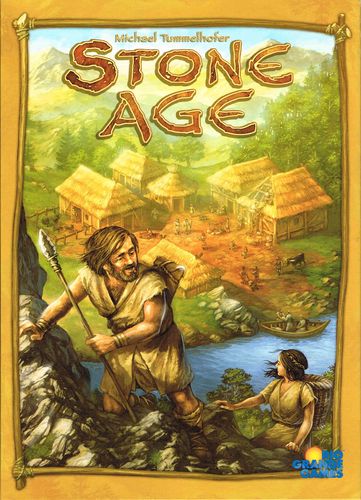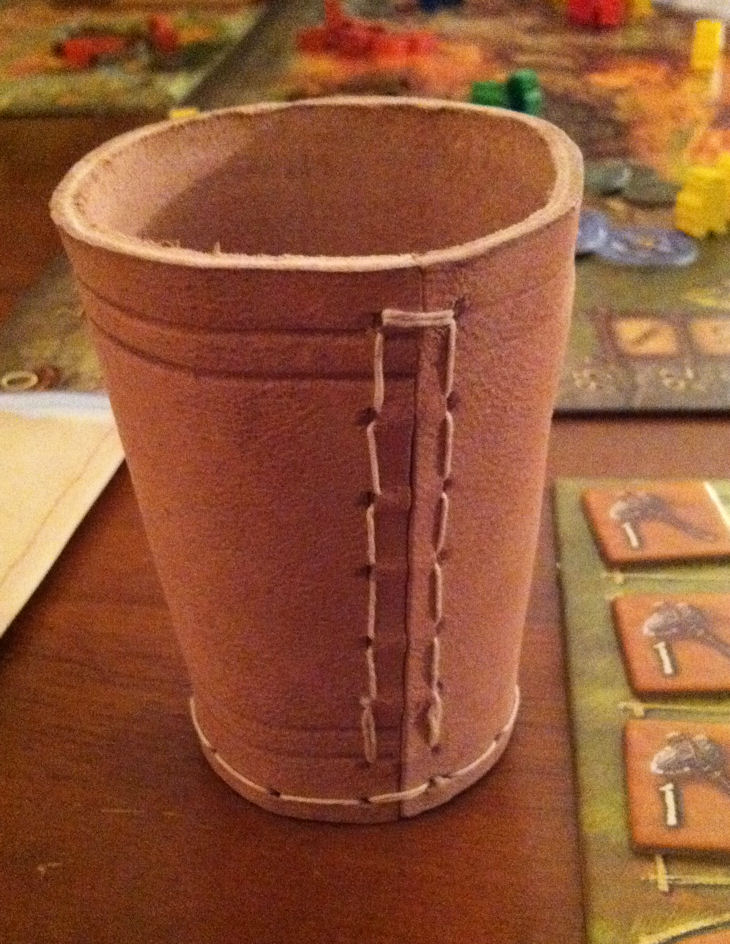 - by Jeremiah
I went to game night to find Stone Age was set up and ready to play. I was informed that I "probably wasn't going to like it..." Thankfully for all of us at the table that prognostication was incorrect.
- by Jeremiah
I went to game night to find Stone Age was set up and ready to play. I was informed that I "probably wasn't going to like it..." Thankfully for all of us at the table that prognostication was incorrect.
Stone Age at its core is a resource-management/workforce-allocation game set in...well, the Stone Age.
The Setup - Players are given a player board and 5 of 10 meeples of their selected color, and 12 food tokens. The board is set slightly differently depending on the number of players with a certain number of structures and civilization cards. And then resource pieces are placed in their respective areas—lumber, brick, stone, gold and food.
The Players Turn - Gameplay consists of rounds more so than turns; there are three phases to a round: placement, production, and nutrition. A player is handed the first player/caveman/king looking thing token and gets to decide where he will allocate his first meeples. Aside from the resource areas players can stake a claim at 3 special areas: the field, the hut, and what I like to call the tool shed. These are highly sought after spots and very limited, only allowing 1-2 meeples (the hut require 2 meeples from the same player) to be placed there, as opposed to the other resource areas allowing for multiple meeples. The field allows you to accumulate 1 food each round, moving your counter up the food track—you'll see why this is valuable shortly. While going to the hut, also known as "The Love Hut," allows players to bring in an extra meeple from their supply. (Now you see why you have to put 2 meeples there.) Going to the tool shed yields one tool; tools help add to your rolls during the production phase. You can also place a meeple on a civilization card (which allows you to purchase it during the production phase) or a structure chip (which you also can purchase during the production phase). Cards give you special abilities during the game and can score points at the end of the game. Structures score you points immediately but give no special powers.
The Production Phase - Once each player has placed all of their meeples, players go in order making all of their production checks and purchasing anything they may have dibs on. This is where the game gets dicey, literally. For each meeple you've placed in a certain area, you get to roll one d6, add the total, optionally modify that total with your tools, and then divide by a certain number depending on the resource you're going for. (Food/2, Lumber/3, Brick/4, etc.) The three special locations don't require rolls; they produce just by having placed a meeple there. You gather resources, because they allow you to buy your civilization cards and structures and in turn score victory points. And that's how you win the game.
The Nutrition Phase - After everyone has gathered resources, bought things, etc., you gather all of your meeples back to your player board, and then pay 1 food token for each of them, minus the number your counter is at on the food track—the higher you get your counter, the less hunting you need to do!
The Game Ends - When all of the civilization cards are depleted, or when one pile of structure cards are depleted. You then add up any final points awarded by the civilization cards and whoever has the most points wins.
 The Cup O'Stink - About 25 minutes into game play there was an awkward exchange of sideways glances at one another. We discovered that the foul smell at the table was not due to any of us lacking in personal hygienic aptitude. But it was in fact due to the the cup which was included for rolling the dice. It was made, apparently, out of real rawhide, or some form of leather. Thematically it was cool. But in essence it just stank. Otherwise the packaging was great; Rio Grande included lots of baggies, and perfect compartments for all of the pieces and components to fit into nicely!
The Cup O'Stink - About 25 minutes into game play there was an awkward exchange of sideways glances at one another. We discovered that the foul smell at the table was not due to any of us lacking in personal hygienic aptitude. But it was in fact due to the the cup which was included for rolling the dice. It was made, apparently, out of real rawhide, or some form of leather. Thematically it was cool. But in essence it just stank. Otherwise the packaging was great; Rio Grande included lots of baggies, and perfect compartments for all of the pieces and components to fit into nicely!
The Bottom Line - Stone Age, was really enjoyable. There are some timing questions that took a little digging to resolve and in fact do have a pretty substantial impact on the game itself. But once you get the nuances hammered out, it plays smoothly and is a lot of fun. If you hate games that rely heavily on dice roles, you may be in for a rough ride, as gathering resources + bad rolls can = a bitter experience. But if you think out your turns a little in advance you can hedge some of the randomness. Thematically, the game is fun. If I'm riding a hard-line Christian view of it, yes, the "Stone Age" really wasn't what games like this, and TV/cartoons make it out to be, neanderthal men living in caves, grunting, and beating each other with large clubs. I view it as a historical fiction game, just as I would look at Battlestar Galactica as a science fiction game. By the way, there is no beating of each other with large clubs in this game; that was pure hyperbole. The "Love Hut," as it were, will cause some Jr. High-ish giggling, but there is nothing lewd about it at all.
Thanks for reading! And as always we love to hear your thoughts on the games we review!















